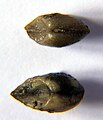| Dacryomya Temporal range:
| |
|---|---|

| |
| Two entire shells of Dacryomya lacryma | |
|
Scientific classification
| |
| Domain: | Eukaryota |
| Kingdom: | Animalia |
| Phylum: | Mollusca |
| Class: | Bivalvia |
| Order: | Nuculida |
| Family: | Nuculidae |
| Genus: | †
Dacryomya Agassiz, 1840 [1] |
| Species [2] | |
| |
| Synonyms[ citation needed] | |
| |
Dacryomya, or the pointed nutclam is an extinct genus of small-sized (approximately 1 centimetre (0.39 in) long) saltwater clams, marine bivalve molluscs in the nutclam family Nuculanidae. The size and shape of the shells of species in this genus are reminiscent of broad apple pips.
Dacryomya lived during the Lower and Middle Jurassic, possibly throughout the Tethys Faunal Province. [3] Fossils of D. lacryma are known from the very late Lower Jurassic ( Toarcian) of France (Causes, 44.3° N, 3.3° E); [4] the early middle Middle Jurassic ( Bajocian) of Germany (Sengenthal); and the very late Middle Jurassic ( Callovian) of India (the Gadhada Sandstone Member and the Chari Formation, 23.5° N, 70.5° E). [5]
The fossil locations cited were open shallow subtidal areas, [4] where this mollusc lived as a facultatively mobile infaunal deposit feeder- suspension feeder. [6]
These additional views of the two shells of Dacromya lacryma give more information about the overall shape of the shell in that species:
- ^ Agassiz, L. (1840). Mémoire sur les moules de mollusques vivans et fossiles. Première partie: Moules d'acephales vivans. Mémoires de Société des Sciences Naturelles de Neuchâtel. 2: 1– 48., available online at https://www.biodiversitylibrary.org/page/10595660 page(s): 34
- ^ MolluscaBase eds. (2024). MolluscaBase. Dacryomya Agassiz, 1840 †. Accessed through: World Register of Marine Species at: https://www.marinespecies.org/aphia.php?p=taxdetails&id=1484903 on 22 July 2024
- ^ W. Kiessling, D. K. Pandey, M. Schemm-Gregory, H. Mewis, and M. Aberhan. 2011. "Marine benthic invertebrates from the Upper Jurassic of northern Ethiopia and their biogeographic affinities". Journal of African Earth Sciences 59:195–214
- ^ a b Fürsich, F.T., R. Berndt, T. Scheuer and M. Gahr. Comparative ecological analysis of Toarcian (Lower Jurassic) benthic faunas from southern France and east-central Spain. Lethaia 34:169–199. 2001 [1]
- ^ F.T. Fürsich. 2006. Unpublished data from Kachchh
- ^ Paleobiology Database
- Karapunar, B.; Werner, W.; Fürsich, F. T.; Nützel, A. (2020). Taxonomy and palaeoecology of the Early Jurassic (Pliensbachian) bivalves from Buttenheim, Franconia (Southern Germany). Palaeontographica, Abteilung A. 318(1–4): 1–127., available online at https://doi.org/10.1127/pala/2020/0098
| Dacryomya Temporal range:
| |
|---|---|

| |
| Two entire shells of Dacryomya lacryma | |
|
Scientific classification
| |
| Domain: | Eukaryota |
| Kingdom: | Animalia |
| Phylum: | Mollusca |
| Class: | Bivalvia |
| Order: | Nuculida |
| Family: | Nuculidae |
| Genus: | †
Dacryomya Agassiz, 1840 [1] |
| Species [2] | |
| |
| Synonyms[ citation needed] | |
| |
Dacryomya, or the pointed nutclam is an extinct genus of small-sized (approximately 1 centimetre (0.39 in) long) saltwater clams, marine bivalve molluscs in the nutclam family Nuculanidae. The size and shape of the shells of species in this genus are reminiscent of broad apple pips.
Dacryomya lived during the Lower and Middle Jurassic, possibly throughout the Tethys Faunal Province. [3] Fossils of D. lacryma are known from the very late Lower Jurassic ( Toarcian) of France (Causes, 44.3° N, 3.3° E); [4] the early middle Middle Jurassic ( Bajocian) of Germany (Sengenthal); and the very late Middle Jurassic ( Callovian) of India (the Gadhada Sandstone Member and the Chari Formation, 23.5° N, 70.5° E). [5]
The fossil locations cited were open shallow subtidal areas, [4] where this mollusc lived as a facultatively mobile infaunal deposit feeder- suspension feeder. [6]
These additional views of the two shells of Dacromya lacryma give more information about the overall shape of the shell in that species:
- ^ Agassiz, L. (1840). Mémoire sur les moules de mollusques vivans et fossiles. Première partie: Moules d'acephales vivans. Mémoires de Société des Sciences Naturelles de Neuchâtel. 2: 1– 48., available online at https://www.biodiversitylibrary.org/page/10595660 page(s): 34
- ^ MolluscaBase eds. (2024). MolluscaBase. Dacryomya Agassiz, 1840 †. Accessed through: World Register of Marine Species at: https://www.marinespecies.org/aphia.php?p=taxdetails&id=1484903 on 22 July 2024
- ^ W. Kiessling, D. K. Pandey, M. Schemm-Gregory, H. Mewis, and M. Aberhan. 2011. "Marine benthic invertebrates from the Upper Jurassic of northern Ethiopia and their biogeographic affinities". Journal of African Earth Sciences 59:195–214
- ^ a b Fürsich, F.T., R. Berndt, T. Scheuer and M. Gahr. Comparative ecological analysis of Toarcian (Lower Jurassic) benthic faunas from southern France and east-central Spain. Lethaia 34:169–199. 2001 [1]
- ^ F.T. Fürsich. 2006. Unpublished data from Kachchh
- ^ Paleobiology Database
- Karapunar, B.; Werner, W.; Fürsich, F. T.; Nützel, A. (2020). Taxonomy and palaeoecology of the Early Jurassic (Pliensbachian) bivalves from Buttenheim, Franconia (Southern Germany). Palaeontographica, Abteilung A. 318(1–4): 1–127., available online at https://doi.org/10.1127/pala/2020/0098


